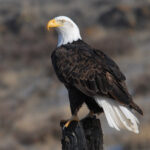The bald eagle is a majestic bird of prey known for its impressive size, powerful talons, and keen eyesight. These adaptations play a crucial role in the bald eagle’s ability to protect itself from various threats. In this blog post, we’ll explore the specific ways in which the bald eagle safeguards itself, providing a comprehensive understanding of this iconic species’ survival strategies.
Keen Eyesight: The Bald Eagle’s Watchful Eyes
One of the bald eagle’s most remarkable adaptations is its exceptional eyesight. With the ability to see up to four times farther than humans, the bald eagle can easily spot potential threats from a distance. This heightened visual acuity allows the eagle to detect and respond to any danger that may approach its territory or nest.
Powerful Talons: The Bald Eagle’s Formidable Weapons
The bald eagle’s talons, or claws, are another essential tool in its arsenal for self-protection. These sharp, strong appendages are used to capture and kill prey, but they also serve as a formidable defense mechanism. The bald eagle can use its talons to fend off predators, such as other birds of prey, and to protect its young from potential threats.
Aggressive Behavior: The Bald Eagle’s Territorial Displays
Bald eagles are known for their aggressive behavior, particularly during the nesting season. When their territory is threatened, they will engage in aerial displays, emitting high-pitched screams to warn off intruders. These displays can also involve physical confrontations, with the eagles using their talons and beaks to defend their nesting sites.
Adaptations for Nesting: Protecting the Next Generation
The bald eagle’s nesting habits also play a crucial role in its self-protection. These birds typically build their nests high up in tall trees or on cliffs, making it difficult for predators to access their young. Additionally, bald eagles are known to fiercely defend their nests, using their powerful talons and beaks to protect their eggs and hatchlings.
Avoiding Human Threats: Adapting to a Changing Environment
While the bald eagle has evolved numerous adaptations to protect itself from natural threats, it also faces significant challenges from human activities. Collisions with vehicles, electrocution from power lines, and lead poisoning from spent ammunition are just a few of the dangers that bald eagles must navigate. To address these threats, conservation efforts have been implemented, including the banning of DDT and the listing of the bald eagle as a federally protected species.
Conclusion
The bald eagle’s remarkable adaptations, including its keen eyesight, powerful talons, and aggressive behavior, are essential to its ability to protect itself from a variety of threats. By understanding these survival strategies, we can better appreciate the resilience and importance of this iconic American symbol. As we continue to coexist with bald eagles, it is crucial that we remain vigilant in our efforts to protect and conserve this majestic species for generations to come.
References:
– https://cbop.audubon.org/conservation/bald-eagle-biology
– https://journeynorth.org/tm/eagle/annual/facts_nestlings.html
– https://kids.nationalgeographic.com/animals/birds/facts/bald-eagle
– https://www.nwf.org/Educational-Resources/Wildlife-Guide/Birds/Bald-Eagle
– https://eagles.org/what-we-do/educate/learn-about-eagles/bald-eagle-behavior/




